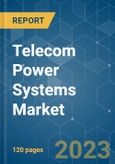Key Highlights
- Telecom power systems comprise rectifiers, batteries, and a power system controller, and they secure telecommunication services in case of grid power interruptions and fluctuations. The telecom power systems market has been mostly driven by the fact that more towers are being put up in different parts of the world. This is due to a number of factors, including changing technologies.
- The increasing need for tower installations is driving the market as the following technologies, such as 4G and 5G, are being deployed. Still, the coverage is relatively lower for 4G and 5G technologies in various regions, so telecom companies need to set up more towers to handle the growing voice and data traffic. As technology improves, so does people's need for speed. At first, speed would vary because there wasn't enough coverage, but that's changing now.
- Using solar energy is a steady method of providing electrical power to telecommunication systems in remote places beyond the main electricity grid, for instance, on mountaintops and vast swamps where power is unavailable or it is impractical to install new power lines. This deployment may become a future trend in this market.
- Power outages, especially in developing economies, have been a major roadblock to adopting the latest access technologies. This problem has irritated service providers, cell site operators, and owners all over the world. A new GSMA study says that there could be more than 50 million 5G connections in the MENA region by 2025 and that about 30% of the region's population will be covered by 5G networks by that time.
- Additionally, renewable energy sources for remote telecommunication systems have become more popular recently due to technological advancements and lower costs. Renewable resources, like the wind and the sun, provide useful energy, lower the overall costs of running the system's infrastructure, and leave less of a carbon footprint.
Telecom Power Systems Market Trends
Access Application in 5G Holds the Significant Share in the Market
- 5G is a recent wireless broadband technology and is marketed as the fifth generation of radio technologies. There is a target for the firms for the bit rate to have peak data rates of 100 MB/s up to 20 GB/s in the downlink. However, 300 MB/s rates have yet to be achieved in practical implementations. 5G employs a sub-6 GHz spectrum ranging from 450 MHz to 6 GHz as well as mmWave frequencies ranging from 24 GHz to 52 GHz.
- This increasing penetration of 5G in such a short span of time can be a major driver for the market studied, as this will fuel the deployment of more cell sites. This improvement in infrastructure isn't just happening in a few countries in the area; it's happening in many.
- With increasing data traffic globally, 5G connectivity will be incorporated in many enterprises to ensure operational efficiency and minimize losses associated with operational breaches. The 5G network will support a variety of technologies, including the Internet of Things (IoT), outdoor robots that can function independently in the agriculture sector, etc.
- DongAh Elecomm supplies rectifier and hot-swap power supply modules, power shelves, and energy systems for the fast-developing and multi-functionalized communications industry. DongAh Elecomm's power is behind the 4G/LTE small cell deployment for South Korea's three major service providers: Korea Telecom, SK Telecom, and LGU+, which deployed more than 300,000 small cell systems across the Republic of Korea over three years.
- According to Ericsson, total mobile data traffic may continue to increase globally and is predicted to reach 131 exabytes per month by the end of 2024. This implies a 30% compound annual growth rate between 2018 and 2024. By 2024, the firm expects that 5G networks will carry 35% of total mobile data traffic.
North America Account for Significant Market Share
- North America has been one of the first places to use most new technologies, and telecom technologies are no exception. In North America, 94% of people have a mobile phone.
- Ericsson says that by the end of 2025, there will be 318 million 5G mobile subscriptions, which is more than 80% of all mobile subscriptions in North America. This may increase the demand for telecom power systems.
- So, to meet the needs of future 5G services in terms of capacity, coverage, and efficiency, network operators in United States are investing in their networks to get the best performance at the lowest cost per bit. They are doing this by using new technologies like network function virtualization (NFV) and software-defined networking (SDN) to make their networks as efficient as possible.
Telecom Power Systems Industry Overview
The telecom power systems market is fragmented with the advent of 4G LTE systems. There will be more players added, which will increase the market's competition. Key players are Eaton Corporation, Huawei Technologies Co., and Cummins Inc.In May 2022, Huawei announced the launch of a new generation of power supply solutions, PowerPOD 3.0. By using an innovative converged architecture and the industry's ultra-high-density UPS5000-H, the power density per cabinet is increased, and the space layout of the power supply system is improved.
In May 2022, Ericsson announced that a trial of Deutsche Telekom's 5G-enabled network had gone well. This could be a big step toward making mobile site operations more sustainable by using renewable energy and balancing supply and demand.
Additional Benefits:
- The market estimate (ME) sheet in Excel format
- 3 months of analyst support
This product will be delivered within 2 business days.
Table of Contents
Companies Mentioned (Partial List)
A selection of companies mentioned in this report includes, but is not limited to:
- Eaton Corporation
- Huawei Technologies Co.
- Cummins Inc.
- ZTE Corporation
- Efore Group
- Eltek AS
- Delta Group
- Alpha Technologies
- ABB Group
- Schneider Electric








